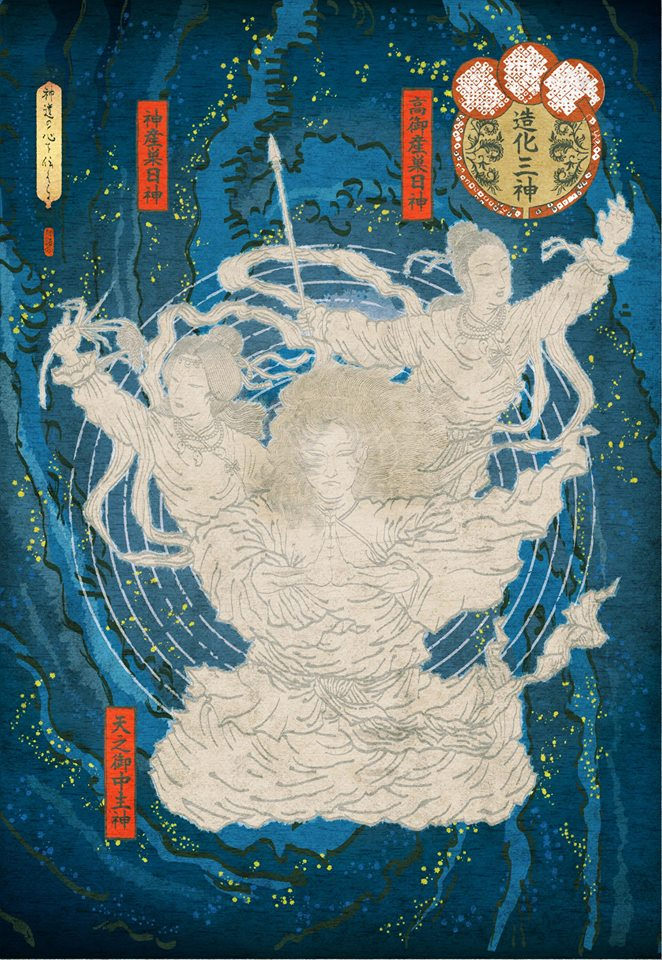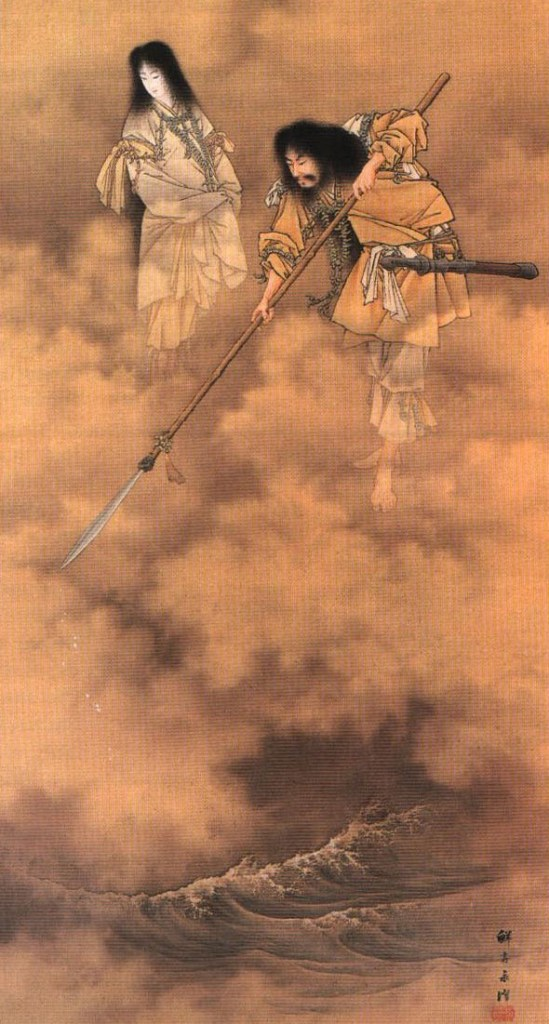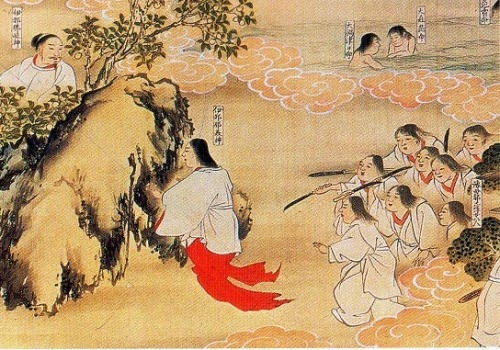Japan's oldest historical record, the Kojiki (古事記; Records of Ancient Matters, 712 CE), and the second oldest book of Japanese history, the Nihon Shoki (日本書紀; The Chronicles of Japan, 720 CE) are both full of Shinto (the polytheistic religion native to Japan) myths and legends. This includes cosmogony, or the creation story of the world and the universe. Some of the figures in the creation myth are rarely mentioned since the books were written, but some play important roles in other Japanese legends and Shintoism.
While Japanese people don't believe this anymore, the creation story is a good place to start if you're interested in Japanese mythology and how it impacts Japanese culture. I'm going to tell that story in (hopefully) plain language. The creation myth is a little different in the Kojiki compared to the Nihon Shoki, but most people go by the Kojiki version, so that's what I'll be using.

When heaven was formed, five deities, the kotoamatsukami (別天津神, The Separate Heavenly Gods) appeared. Three came into being before the last two and are known as the zouka-sanshin (造化三神, The Three Creation Gods). These five kami (神, god or deity) were hitorigami (独神, Lone God) because they appeared spontaneously (as opposed to a male-female pair, which most gods are said to come from), didn't have a partner, and were essentially gender-less. After these kami emerged, they went into hiding.
From there emerged the kamiyo-nanayo (神世七代, The Seven Generations of the Age of the Gods). Two more hitorigami appeared, followed by five pairs of male-female kami. Also like many myths throughout the world, these pairs were husband and wife, but also brother and sister.
While there is an innumerable amout of kami now, the Japanese creation myth shows how the first 17, the 5 kotoamatsukami and the 12 kamiyo-nanayo, emerged. The last pair of the kamiyo-nanayo were Izanami (伊邪那美神, She-Who-Invites) and her brother Izanagi (伊邪那岐神, He-Who-Invites). Izanagi and Izanami are two of the most important kami and are said to be the parents of hundreds to millions of other kami.

After kuniumi, the kamiumi (神産み, Birth of Gods) occurred. After creating the islands of Japan, Izanagi and Izanami birthed many kami, some male, some female, and some genderless. Giving birth to their last child, Kagutsuchi, the god of fire, Izanami was fatally injured. From her dying body some kami were born, and Izanagi's tears while mourning her death birthed more kami. He then got so upset that he killed Kagutsuchi with a sword and cut him into 8 pieces, which created 8 volcanoes. Also from Kagutsuchi's body 8 more kami were born, and his blood on the sword and surrounding rocks created another 8 kami.
According to Shinto mythology, there is a land of the dead called yomi (黄泉, literally "yellow spring"; the real meaning of yomi is unknown in Japanese, but the writing came from Daoism). Izanagi went to yomi to bring Izanami back, but found out that she had already eaten food in yomi, which makes it incredibly hard for one to leave. Izanami said that she will ask the gods of yomi if she could leave, but Izanagi would have to promise to not look at her, to which he agreed. She was taking a long time and Izanagi got worried, so he lit his comb from his hair to create some light in order to look for her. He eventually found her, but saw that her body was now a rotting corpse. He was scared, so he decided to abandon his wife and leave. Izanami was so embarrassed that her body bore eight thunder kami, and she commanded the yomotsu-shikome (黄泉丑女, female demons from yomi) to chase him.
While being chased, Izanagi threw his headress, which turned to grapes, and his comb, which turned into bamboo, making the shikome stop to eat. Izanami then sent yomi warriors and the 8 thunder kami after him, but Izanagi threw three peaches at them, so they ran away (peaches were thought to have evil-banishing magic at the time). At the slope that connects the land of the dead and the land of the living, Izanami and Izanagi met, and Izanagi lifted a huge rock and blocked the path (which is said to be in Matsue, Shimane Prefecture). Izanami yelled over the rock and said that if he leaves her she will kill 1,000 people every day, to which Izanagi replied by saying that he will ensure that 1,500 be born every day. That was the last time they saw each other, dissolving their marriage with Izanagi becoming the ruler of the living and Izanami becoming the ruler of the dead.
After leaving yomi, Izanagi decided to perform misogi (禊, a Shinto purification ritual) in a river to cleanse himself. Performing this ritual created 23 kami; the last step of the ritual created an additional 3 kami, known as the mihashira no uzu no mikoto (三貴子, Three Precious Children), the three most important kami in Shintoism. Amaterasu ( 天照大御神, roughly means 'The Light of Heaven'), the female goddess of the sun, was born from the washing of Izanagi's left eye. Tsukuyomi (月読命, roughly means 'Reader of the Moon'), the gender-less deity of the night, was born from the washing of his right eye. Finally, Susano'o (須佐之男命, probably means 'the man/male god from Susa'), the male god of the seas and storms, was born from the washing of his nose. This is why we wash our hands at the entrance of shrines and temples: to cleanse ourselves before entering a sacred place.
These myths explained how the universe and kami came to be, creating the basis for other Shinto stories and beliefs. The story of Izanagi and Izanami, along with stories about Amaterasu and Susano'o, are some of the most well known. I'm going to be writing about the Three Precious Children next, so stay tuned if you want to know more Japanese mythological stories!